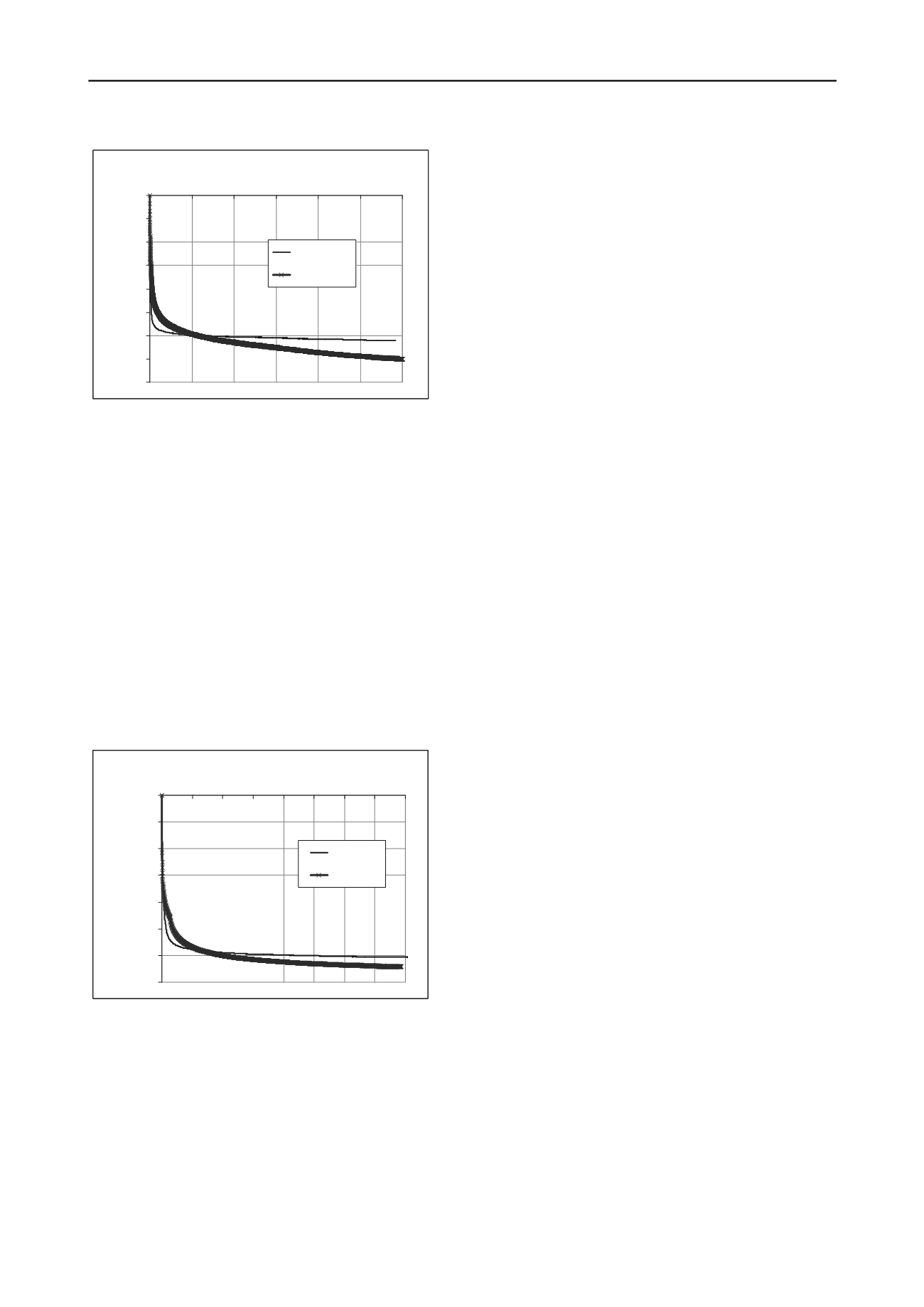
894
Proceedings of the 18
th
International Conference on Soil Mechanics and Geotechnical Engineering, Paris 2013
-0.8
-0.7
-0.6
-0.5
-0.4
-0.3
-0.2
-0.1
0
0
4
8
12 16 20 24
time (h)
Vertical displacements (mm)
EC1 (0V)
EO2 (6.35V)
Figure 8. Evolution in time of the vertical displacements under the
vertical stress of 50kPa in tests EC1 and EO2.
5 RADIAL CONSOLIDATION TESTS
As mentioned before, a similar study was made for the radial
flow tests EOR and ER. Figure 9 is similar to Figure 8 but
presents the vertical deformations measured in the tests EC1
and ER, when the vertical stress of 50kPa is applied (load
increment of 25kPa). Deformations are shown instead of
vertical displacements to account with the different heights of
the specimens. The curve from ER test was corrected to account
with the stiffness of the equipment (including drains, top
geotextile and load plate). When the two curves are compared it
can be seen that the deformations measured in EC1 after 24h (at
the end of the consolidation) were reached in test ER about
2hours after load increment (12 times faster than if there would
be no drainage). This increment is larger than the one observed
when tests EC1 and EO2 are compared, which indicates that the
efficiency of radial drainage in accelerating consolidation is
higher than that of electroosmosis.
-0.035
-0.030
-0.025
-0.020
-0.015
-0.010
-0.005
0.000
0 1 2 3 4 5 6 7 8
time (h)
Vertical deformations
EC1 (0V)
ER (0V)
Figure 9. Evolution in time of the vertical deformations under the
vertical stress of 50kPa in tests EC1 and ER.
There is no significant difference in the results found for the
two tests performed with drainage in the radial direction. For
the test where electrical current was applied the anode was in
the exterior circle and the cathode was in the interior circle. The
comparison of the values measured for the coefficient of
consolidation in the radial direction (1x10
-4
m
2
/s, independently
from the use or not of electrical current) (Nogueira Santos,
2012) and those measured in the oedometric cells presented in
Figure 7 shown that the main mechanism of water drainage in
these tests is through the drains because the values in radial
direction are about one order of magnitude higher than those in
the vertical direction. The values of the coefficient of
consolidation in the radial direction slightly increase when
electrososmosis occurs but the increments are not significant.
This may be explained by the fact that the drains, both in anode
and cathode, were left open and water could flow also as in the
test where electricity was not used.
The small difference between the cases using drains with and
without voltage shows that the inclusion of electrical current
brings no evident earning in time savings for the particular case
of radial drainage. The application of electrical current may
eventually reduce the number of drains but it will affect their
radial efficiency and this must be studied in the future.
6 CONCLUSIONS
The study presented confirms that electroosmosis accelerates
the one-dimensional consolidation of clayey soils because the
consolidation coefficient
c
v
increases about one order of
magnitude. This is a very significant improvement.
The studies where an electrical field was applied for 24h
indicated that the settlement obtained can be larger than if there
was no electrical current. For this reason the duration in time of
the treatment must be controlled. For the one-dimensional
consolidation tests performed, the use of electrical current
allowed reducing the consolidation period in a factor of 6.
Regarding the value of voltage applied to the soil, higher
voltages can result in larger settlements if they are applied the
same period of time. It can be deduced that the time during
which voltage is applied can be reduced if high voltages are
applied, as long as they are safe in the field.
Accordingly with the results of the tests with radial
consolidation, considering the overlap between radial and
vertical directions taken as a hypothesis for Esrig (1968), if the
drains mesh is well designed, the inclusion of radial drainage
direction has the most important role. Eventually, drainage in
the vertical direction may not be considered.
The inclusion of radial drains without any electrical current
allowed reducing the consolidation period by a factor of 16,
which is 2.6 times larger than the factor found for the one-
dimensional consolidation test with electroosmosis. Comparing
the two techniques for accelerating consolidation, although the
good results obtained when electrical current is used, the
reduction achieved may not compensate the cost increment due
to the energy spent with the process, as well as the need of
specialists to install and control the technique. The installation
of drains is proven to be efficient and economical, which
explains the use of this technique in practical and current cases.
Nevertheless, it is believed that the use of electroosmosis can be
advantageous in Environmental Geotechnics problems and for
this reason studies like the one presented will be useful to
understand better the potentiality of this technique.
7 REFERENCES
Esrig, M. 1968. Pore pressures, consolidation, and electrokinetics.
Journal of the Soil Mechanics and Foundation Division
. ASCE, vol
94 SM(4), pp. 899-921.
Glendinning S., Jones C.J. and Pugh R.C. 2005. Reinforced Soil Using
Cohesive Fill and Electrokinetic Geosynthetics.
International
Journal of Geomechanics
, vol 5(2), pp.139-146.
Mitchell, J. and Soga, K. 2005.
Fundamentals of Soil Behavior
, 3
rd
Edition. John Wiley and Sons.
Nogueira Santos, J. 2012.
Study on the use of electrical techniques for
accelerating the consolidation of clayey soils
. MSc Thesis, Instituto
Superior Técnico, Universidade Técnica de Lisboa (in Portuguese).
Terzaghi, K., Peck, R.B. and Mesri, G. 1996.
Soil Mechanics in
Engineering Practice
, 3
rd
Edition. John Wiley and Sons, Inc.


